Off Paper: The Hidden Cost of Home-based Workers
By: Aastha Jain , member of Fashion Revolution India
 No Policies, No Records—42 million home-based workers remain systematically invisible, with approximately 19% engaged in apparel production. As a policy researcher with the Fashion Transparency Index Working Group between September 2024 and December 2024, I met several women stitching buttons and embroidering and overturning socks in Delhi’s dense colonies, revealing the mechanisms through which capitalist structures perpetuate exploitation, transforming homes into sites of economic negotiation.
No Policies, No Records—42 million home-based workers remain systematically invisible, with approximately 19% engaged in apparel production. As a policy researcher with the Fashion Transparency Index Working Group between September 2024 and December 2024, I met several women stitching buttons and embroidering and overturning socks in Delhi’s dense colonies, revealing the mechanisms through which capitalist structures perpetuate exploitation, transforming homes into sites of economic negotiation.
The informal sector has three archetypes: contractors, piece-rate workers, and self-employed workers. Their labour encompasses completing semi-finished apparel and accessories like bags, shoes, cushion covers, and bangles, assembling bindi packets, attaching buttons, applying trims, packaging, labeling, embroidery, and crochet.
 Fixed contractors connected to factories function as intermediaries who distribute work daily or weekly in different neighborhoods. Factories dictate compensation for the contractors. The contractors extract a 40-50% margin before redistributing wages. Piece rates demonstrate huge variability, fluctuating based on geographical location, distance from factories, labour demand, and skills scarcity—ranging from INR 1 ($0.012) to INR 70 ($0.83) per piece. The COVID-19 pandemic exacerbated existing vulnerabilities. Unlike other sectors experiencing recovery post-pandemic, this trade witnessed a wage decline. Contractors, who also tend to be migrant workers, often run away with the due amount. Those who stay nearby or in the same neighborhood as workers show cooperation and timely payment.
Fixed contractors connected to factories function as intermediaries who distribute work daily or weekly in different neighborhoods. Factories dictate compensation for the contractors. The contractors extract a 40-50% margin before redistributing wages. Piece rates demonstrate huge variability, fluctuating based on geographical location, distance from factories, labour demand, and skills scarcity—ranging from INR 1 ($0.012) to INR 70 ($0.83) per piece. The COVID-19 pandemic exacerbated existing vulnerabilities. Unlike other sectors experiencing recovery post-pandemic, this trade witnessed a wage decline. Contractors, who also tend to be migrant workers, often run away with the due amount. Those who stay nearby or in the same neighborhood as workers show cooperation and timely payment.
A shared space for home and work exposes profound gender-based contradictions. Women, responsible for domestic labour, are compelled to negotiate complex frameworks—first fulfilling family responsibilities, then pursuing work in the remaining time. Women decide whether they can accommodate more labour or not as per their domestic schedule. Many women are not allowed to move outside, rendering home-based work as a survival strategy. Work remains fundamentally precarious: no monthly guarantees, with labour oscillating between hectic periods and prolonged intervals of scarcity. The irregularity breeds systemic mistrust and hopelessness, compelling some to abandon this labour mode while others persist as a final economic recourse.
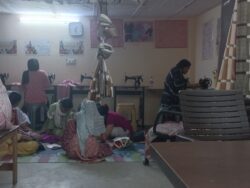 To meet their basic needs, workers try to maximise work, generating low piece-rate wages. Such compensation structures incentivize maximum labour extraction. Families, including children who spend substantial amounts of time with mothers, become integrated into production processes. The fundamental contradiction emerges: how can corporations proclaim freedom from forced or child labour when entire communities are economically coerced into such labour arrangements?
To meet their basic needs, workers try to maximise work, generating low piece-rate wages. Such compensation structures incentivize maximum labour extraction. Families, including children who spend substantial amounts of time with mothers, become integrated into production processes. The fundamental contradiction emerges: how can corporations proclaim freedom from forced or child labour when entire communities are economically coerced into such labour arrangements?
In Delhi, workers inhabit densely populated neighborhoods characterized by open sewage systems, intermittent electricity supply, water scarcity, and inadequate ventilation. Typical living rooms(a 10 x 10 feet space)egregiously contradict International Labour Organization (ILO) conventions mandating workspace requirements. Workers absorb additional economic burdens, including electricity costs, healthcare expenses, and workspace rental, which remain strategically unaccounted for in supply chain calculations.
“Bindi sticking impacts eyesight, back pain, and exposure to chemicals severely. Another such hazard is from clothes made with chemical dyes. During extreme heat in summer, dyes stick to hands causing skin infections. No provision of safety gears, social security schemes, healthcare provisions worsen the worker’s conditions.” – Subadhra Pandey, Representative SEWA in Delhi
 Unionization of informal workers confronts multifaceted obstacles: absence of direct employer contact, lack of governmental protective mechanisms, and the invisibility of home-based labour. Brand identification by workers and the union is impossible within this fragmented production ecosystem. Merely 0.25% of workers comprehend their position within broader supply chains, mentions Subadhra. The proliferation of counterfeit products further obscures potential accountability mechanisms.
Unionization of informal workers confronts multifaceted obstacles: absence of direct employer contact, lack of governmental protective mechanisms, and the invisibility of home-based labour. Brand identification by workers and the union is impossible within this fragmented production ecosystem. Merely 0.25% of workers comprehend their position within broader supply chains, mentions Subadhra. The proliferation of counterfeit products further obscures potential accountability mechanisms.
SEWA is a union of 2.9 million informal workers. SEWA in Delhi serves 70,000 workers out of which 7,000 work in the garment industry as home-based workers. Along with other South Asian organisations, the union has developed a transparency tool called Wage Card to document monthly work and negotiate for fair wages. This tool records transactional details, work performed, payments due, and brand associations.
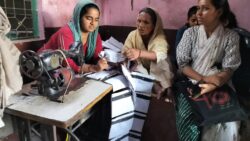 The fundamental struggle demands systemic recognition. Unions articulate comprehensive demands: joint employer responsibility, profit redistribution, social security provisions, regular work, minimum wage guarantees, and most importantly ratification of international labour conventions- C177.
The fundamental struggle demands systemic recognition. Unions articulate comprehensive demands: joint employer responsibility, profit redistribution, social security provisions, regular work, minimum wage guarantees, and most importantly ratification of international labour conventions- C177.
The invisibility of home-based workers reinforces profound epistemic violence—where labour is essential yet systematically marginalized. Most workers do not even acknowledge themselves as workers but as homemakers, wives, or mothers. Their work remains unacknowledged by governments, employers, and manufacturers alike. The hidden costs—including electricity, tools, healthcare, family labor, and unpaid wages—create a perception of cheap production, enabling brands to increase profits by transferring economic burdens to the working class of producing nations.
–
The article is written by Aastha Jain, a visual designer and researcher. She is also a member of Fashion Revolution India. The insights are based on discussions with Subadhra Pandey, Representative SEWA in Delhi, and home-based workers from Delhi. For contact, reach at: aasthajn29@gmail.com
On Paper: Worsening Conditions of Labour in India’s Garment Sector
By: Aastha Jain , member of Fashion Revolution India
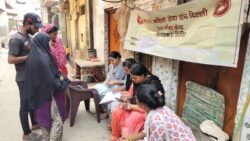
The conditions of workers in producing nations like India reveal a stark contradiction: despite increasing international legislative protections, workers’ lived experiences continue to deteriorate. The acts of intensifying production and alienation of labour have left the workers isolated with stagnant minimum wages and growing monopolization of brands and suppliers. During my time as a policy researcher with the Fashion Transparency Index Working Group between September 2024 and December 2024, I discussed with the union leaders and researchers, the conditions of the garment workers on the shop floor, and the conditions of piece-rate home-based workers in India.
Rukmini VP, President of Garment Labour Union(GLU) highlights that amongst 72 sectors across industries in India, only 4 sectors namely Garment, Leather, Spinning, and Textile have the lowest wages; INR 8,000 ($95) – INR 12,000 ($143) per month (p/m). As per the national law, minimum wages have to be revised every 3-5 years, yet it has stagnated for over a decade in many states. Even if it gets revised its implementation is rare, often retaliated by the factory owners with court cases.
Labour requiring an average of 9 to 11 hours per day (which contradicts Indian Labour Law that limits to 48 hours a week), and paying less than $100 p/m, can increase up to 14 to 16 hours per day during peak seasons.“Workers are allowed a maximum of 30-minute break, and even this is contingent on meeting punishing production targets of 150-200 garment pieces per hour,” says Rukmini VP. Rampant harassment, caste-based discrimination, poor healthcare, and childcare facilities, are further deteriorating the physical, social, and mental conditions of a worker.
“Workers are allowed a maximum of 30-minute break, and even this is contingent on meeting punishing production targets of 150-200 garment pieces per hour,” says Rukmini VP.
The gendered nature of the workforce amplifies these economic challenges. A predominantly female workforce (around 90%) migrates across states to manufacturing districts, being first-generation industrial workers. These migrant workers face heightened risks of harassment, possess weak negotiation power, and experience job insecurity. Underage girls between 14 and 15 years enter factories using falsified age certificates.

In addition to this exploitation which leaves individual workers vulnerable, organising resistance is also made difficult. According to interviewed union representatives, In India, less than 4% of the working class in the garment industry are part of unions. Additionally, they state that the brands, and factories employ extreme forms of tactics to suppress workers from organizing, including targeting the workers, surveillance, economic intimidation, creating yellow trade unions, stopping purchase orders (stop sourcing from that vendor), terminating employment, and threatening organizers, amongst others.
Paradoxically, increasing compliance has created new forms of exploitation. The documentation process has become so complex that specialized firms now solely manage supplier paperwork. Small manufacturers unable to navigate this bureaucratic labyrinth are being systematically eliminated, establishing a monopoly on large manufacturers. The legitimacy of submitted documentation also remains highly non-reflective of the conditions. It remains unreliable due to sole commitment to paper as a tool for auditing. There are no third-party audits or unplanned visits to verify the information shared in the submitted documents. Factory visits are meticulously planned, with workers threatened to maintain silence. The auditors do not engage with the unions who could bear testimony to the true working conditions.

Brands have transferred their responsibility and accountability of ensuring decent working conditions to the suppliers without transferring actual ownership or profits: a sublime act of class manipulation. This paper trail becomes a shield, protecting brands from accountability while maintaining the illusion of ethical production. Workers remain trapped in a system where documentation matters more than real working conditions.
Paper emerges as an instrument of oppression, simultaneously serving as a survival mechanism for the oppressed. Entrenched in their accumulated wealth, the ruling class wields economic instruments, crafting an illusion of autonomy while sharpening the blades of systemic exploitation. Combating global capitalism’s inherent transnational nature, the struggle demands international solidarity. Amidst poor implementation of local state mechanisms, trade unions increasingly rely on global support to negotiate effectively. Their core demands remain fundamental: joint employer responsibility, living wages, union recognition, regular unannounced inspections, and dignified working conditions.
——
The article is written by Aastha Jain, a visual designer and researcher. She is also a member of Fashion Revolution India. The insights are based on discussions with Rukmini VP, Garment Labour Union, Nandita Shivkumar, labour Rights Researcher, and Thivya Rakini, Tamil Nadu Textile Commons Unions. For contact, reach at: aasthajn29@gmail.com
By: So Young Park – Country Coordinator at Fashion Revolution South Korea
We all have old T-shirts with stretched or frayed necklines from countless days of wear and tear. I have clothes tucked away in the back of my wardrobe that I occasionally pull out to reminisce. Volunteering with Fashion Revolution for the past three years has taught me that fashion activism isn’t just about buying clothes with a “sustainable” label. Instead, it’s about digging through your wardrobe, pulling out old clothes, and finding ways to breathe new life into them. I waited until a hole the size of my thumb appeared in a favorite shirt, figured out how to sew it up, covered the hole with thread in my favorite color, and now enjoy the satisfaction of wearing it every time.
My journey into sustainable fashion began in 2020 in a small Batik studio in Jakarta, where I met passionate textile enthusiasts. There, I learned about the craft, history, rituals, and the deep connections between textiles, communities, and respect for nature. This experience profoundly shifted my perspective on life, extending far beyond textiles and fashion. I came to understand that clothing is more than just fabric on our bodies; it represents an ongoing dialogue with the people who make it. It is not something disposable to be taken and thrown away.

In 2021, while traveling through the beautiful landscapes of West Java, I witnessed a polluted river filled with industrial waste and a mountain littered with discarded clothes. It was a shocking sight. My nine-year-old son looked at me and said, “Mum, we have to do something for the planet.” His words stayed with me, and I began searching for ways to make a difference. Together with the dedicated members of Fashion Revolution South Korea, I’ve been volunteering to create digital campaigns that raise awareness about the complex fashion supply chain and its social and environmental impacts. These efforts include an exhibition called ‘Sa-o-ot (Love Clothes Last)’, which highlights the stories of people who have cherished their clothes for years, and translating and distributing the Fashion Transparency Index.
My nine-year-old son looked at me and said, “Mum, we have to do something for the planet.” His words stayed with me, and I began searching for ways to make a difference.

Through translation projects, I’ve met an incredible range of people—fashion designers, students, beauty industry researchers, educational planners, ESG consultants, and others—who have all said that participating in translation and campaign efforts raised their awareness. They expressed that the Fashion Transparency Index helped them understand industry changes and identify areas in need of improvement.
Year after year, the data in the report highlights key issues, revealing both progress and persistent challenges. The fashion industry’s impact varies profoundly across countries, often with devastating consequences. As detailed in the report, fashion can mean vastly different things depending on where you are: from glamorous runway shows to disposable trends that exploit vulnerable communities. In some countries, fashion is tied to women’s rights and freedoms. In others, it’s synonymous with sacrificing children’s education, clean water, and safe working conditions in favor of profits. Each country faces its unique challenges and issues to address within the fashion industry. South Korea, as one of the leading countries in the fashion industry, is no exception to these challenges including the struggles faced by small and medium-sized enterprises (SMEs) due to the weakening of the domestic production base. 
Despite these challenges, there is a universal set of values and directions we must pursue. We must recognize that these issues are not merely obstacles to overcome but opportunities to serve as turning points toward a sustainable future. On Volunteer Day, we honor the countless individuals who dedicate their time and effort to these principles. May their contributions fuel the growth of a just and green transition, paving the way for a more sustainable and equitable future.
By: Claudia Castanheira – Communications Manager at Fashion Revolution Brasil

After two weeks of complex negotiations and over a day of delays, COP29 concluded with the resignation of the poorest and most vulnerable countries, forced to accept a climate finance deal far below the $1 trillion annually demanded by 2035. The final agreement settled on $300 billion per year for climate financing until 2035, the result of over 30 hours of tense talks and setbacks.
Countries in the Global North, including the European Union delegation, the United States, and Canada, who advocated for less ambitious targets, were widely criticized by international observers and NGOs. The European bloc was even awarded the “Fossil of the Day” on November 20, a symbolic prize given by the Climate Action Network (CAN) to those seen as blocking progress during climate talks.
It’s important to highlight that without adequate financial resources, it will be impossible for countries — particularly those in the Global South — to implement climate actions for adaptation, mitigation, and a just energy transition. This lack of funding also puts the Paris Agreement’s goal of limiting global warming to 1.5°C at risk.
Another notable point was the lack of clear commitments to energy transition — including the phase-out of fossil fuels, a central theme of COP28 in Dubai. This objective, removed from the final document in 2023, was not explicitly reinstated in the agreement signed on Saturday, marking a victory for oil and gas-producing countries.
In a geopolitical context marked by wars and crises, achieving significant progress was expected to be a challenging task. However, the general feeling is that this COP resulted in few, if any, meaningful achievements, increasing distrust in the multilateral process to address the climate crisis.
Fashion at COP29
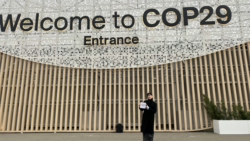
Fashion Revolution Brazil took part in COP29, engaging in discussions with civil society and other stakeholders to highlight the crucial role of fashion and textiles in addressing the climate crisis.
While formal negotiations left much to be desired, we came out stronger: Building new connections and forging global partnerships, which are essential for driving transformation in the industry.
As a civil movement, being part of these spaces is absolutely necessary. Even in the face of roadblocks and insufficient decisions, we reaffirmed our commitment to pursue a more transparent, fairer, and more sustainable fashion industry.
As members of the Brazilian delegation, we put forward clear demands:
For brands:
- Be transparent about how and where clothes are made, how many pieces are produced, and the social and environmental impacts of their production.
- Set ambitious targets for decarbonization and degrowth, and be clear about how these goals will be achieved.
- Publicly share updates on progress and concrete actions to meet these targets.
For policymakers:
- Develop policies to support Brazil and other garment-producing countries facing climate crises and vulnerabilities.
- Prioritize efforts to cut greenhouse gas emissions in the global fashion industry.
- Ensure small suppliers and family farmers have access to financial resources to build resilience against climate change.
At the event, we presented key reports, including What Fuels Fashion, a climate-focused analysis of the Global Fashion Transparency Index, and the latest edition of the Fashion Transparency Index Brazil, which reviews six years of progress and challenges in the industry.
COP30: What is next?
 Looking ahead, our goal is to mobilize the world’s largest civil movement for fashion to come together at COP30 in Belém, Brazil. This will be a landmark event: Brazil is the world’s top exporter of cotton, yet it faces major challenges like carbon emissions from deforestation and a dependency on fossil fuels.
Looking ahead, our goal is to mobilize the world’s largest civil movement for fashion to come together at COP30 in Belém, Brazil. This will be a landmark event: Brazil is the world’s top exporter of cotton, yet it faces major challenges like carbon emissions from deforestation and a dependency on fossil fuels.
The takeaway from COP29 is clear: COP30 must tackle the issues that remain unresolved. We’ll be there in the Amazon rainforest, demanding an end to fossil-fueled fashion and advocating for the rights of those most affected by the climate crisis, often the women who make our clothes.
The fashion climate agenda is just getting started!
Standing together with #FashionforClimate
What can you (citizens) do?
The most anticipated and much-awaited event in VegFest 2023 is the VegFest Runway. A sustainable fashion show that has become a highlight of the festival. This year’s event resonated with creativity and resilience even in the face of a tropical storm. It showcased how fashion can contribute to preserving the environment and saving it from the climate crisis.
The VegFest Runway captivated a blend of innovative designs from three visionary fashion designers and a celebrity stylist. Together, they illustrated the impactful mantra of recycling, reusing, and reducing or the 3Rs. Through these compelling collections, the 3Rs define modern sustainable fashion.
A Showcase of Creativity and Sustainability
The first collection was called “Simply Trashion.” It captivated the audience with its transformative use of everyday recyclable materials. The designer turned empty plastic wrappers into stunning pieces. Shredded rice sacks were also used. They challenged conventional norms about waste by incorporating repurposed fabrics.
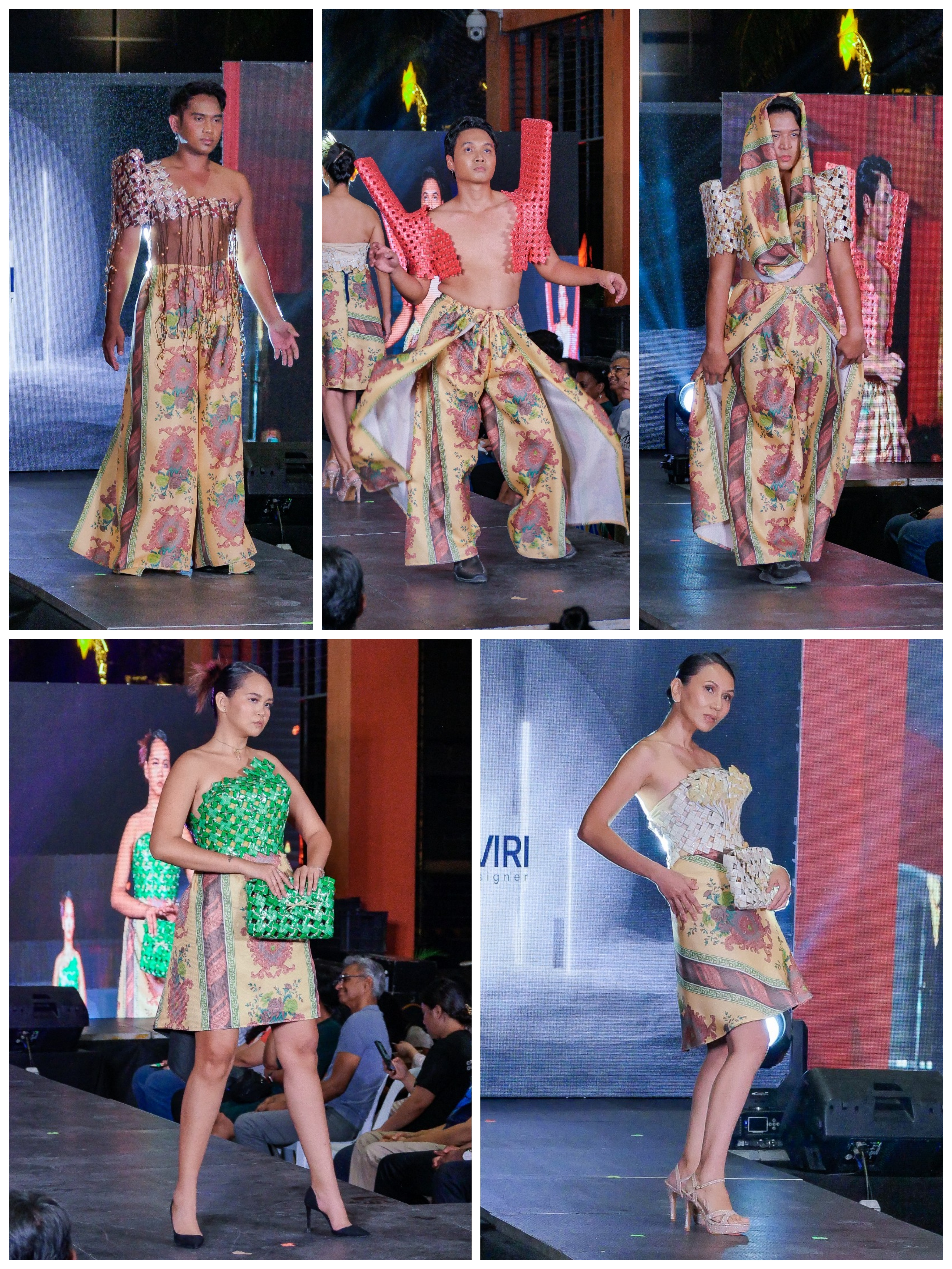
Leby Le Moría followed with a profound presentation. The attendees were treated to a collection that embodied years of introspection. The notion that vulnerability can be a source of strength is an inspiration. Each piece from her collection represented a chapter of her journey. Intricately woven with humanism and creativity.
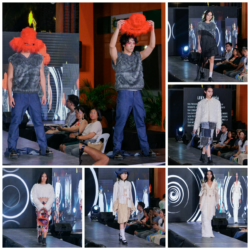
Next in line is Twinkle Ferraren’s Style Isle. The tropical landscapes of the Philippines influenced here we’ll renowned island wear designs. Putting together local artisans and indigenous tribes to encapsulate Filipino artistry. Ferraren’s collection showcased the rich Filipino heritage, and sustainably sourced textiles and accessories.
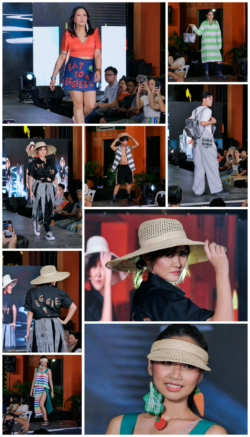
The show’s pulse quickened with celebrity eco-stylist and author Miss Kayce. She highlighted the vegan statement collection in advocating for positive change. Miss Kayce inspired the volunteer models to mix creatively and match pieces from their existing wardrobes. Aligned to their fashion choices with a vegan philosophy. A philosophy while promoting conscious consumerism.
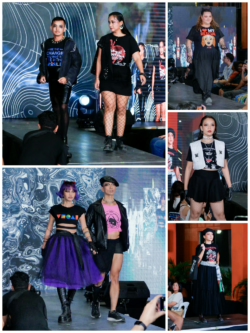
A Spotlight on Emerging Talents
The next day of VegFest 2024 is dedicated to students from SoFA Design Institute. They presented their unique street wear creations on the runway. Their instructor, Irene Grace Subang, guided their creativity to new heights. These budding designers utilized textile scraps donated by Barrios Studios.
Three esteemed experts in sustainable fashion judged the students. The judges are Prince Jimdel Ventura of Wear Forward, Buena Sawit of Barrios Studios, and celebrity stylist author Miss Kayce. They judged the students’ efforts across three categories: Best in Upcycled Construction, Most Innovative, and Best Collection. Additionally, the audience had the chance to vote for their favorite, culminating in an exhilarating People’s Choice award.
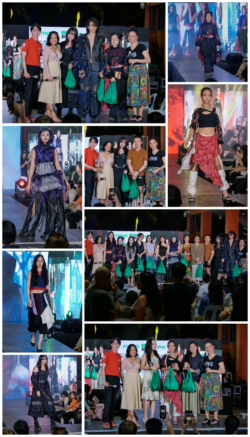
Embracing Eco-Consciousness
The VegFest Runway 2024 persevered to continue despite the looming threat of tropical storm Man-Yi. A powerful reminder of the fashion industry’s potential to drive environmental awareness. It served as a platform for creative expression and also as a conduit for inspiring actionable change.
VegFest Pilipinas, in collaboration with Fashion Revolution Philippines, reiterated its commitment to sustainable fashion. Leaving an indelible mark on the attendees and participants alike. The event successfully merged the worlds of fashion, environmentalism, and cultural heritage. It promoted a collective consciousness toward a more sustainable future.
As the final curtain fell, it was clear. The VegFest Runway has once again proved that style and sustainability can walk hand in hand. Where change is more than envisioned but it’s being woven into the very fabric of our lives.
HEY BIG FASHION BRANDS,
START FINANCING YOUR DECARBONISATION NOW!
COP29, the 29th Conference of the Parties to the United Nations Framework Convention on Climate Change, is poised to be a pivotal event in the global fight against climate change. As usual, the conference will bring together world leaders, negotiators, and stakeholders to assess progress on climate commitments made during previous COP meetings and to discuss strategies for achieving the goals of the Paris Agreement. But we are all fatigued from discussions and commitments, the time is running out and we urgently need action.
As many stakeholders are referring to COP29 as ‘the finance COP’, with negotiations seen as critical to advance a range of financial tools and instruments to support actions to address climate change, we want to reinforce our calling on major fashion brands to invest at least 2% of their revenue in a fair transition away from fossil fuels – like coal – to renewable energy sources – like wind and solar – to power fashion’s supply chain in a clean way.
Fashion is fueling the climate crisis, and major fashion brands must urgently put their money where their emissions are.
Fashion is one of the most polluting industries on the planet, with fossil fuels burned at every stage of production. The industry alone is set to overshoot the 1.5°C limit by 50%, doubling emissions rather than halving them as the science is crying out for. Frequent climate catastrophes, like extreme heat, flooding, and droughts are devastating the livelihoods of workers across global garment supply chains, with extreme weather estimated to cost nearly one million jobs by 2030.
Fashion Revolution’s new report, What Fuels Fashion? reviewed 250 of the world’s largest fashion brands and retailers and ranked them according to their level of disclosure on climate and energy-related data in their operations and supply chains. The findings revealed that major fashion brands aren’t doing enough to cut fossil fuel use in their supply chains. 86% of major fashion brands lack a public coal phase-out target, and only 3% disclose the level of financial support provided to supply chain workers affected by the climate crisis.
By investing at least 2% of their revenue into clean, renewable energy and upskilling and supporting workers, fashion could simultaneously curb the impacts of the climate crisis and reduce poverty and inequality within their supply chains. Climate breakdown is avoidable because we have the solution – and big fashion can certainly afford it.
Our Demands for Fashion Brands:
- Tell us about your clothes: How and where they were made, how many were produced.
-
- Disclose your annual production volumes
- Disclose the fiber mix of your clothes and why are these fibers
- Disclose the prices you pay to suppliers for each item and the wages that workers receive for the production of your garments
- Tell us about your impact: Measure your environmental and social impact and disclose it.
- Disclose your supplier lists (Tier 1 and Tier 2) in an open source easy to usee for others (such as excel, csv or json)
- Disclose your fuel mix across your supply chains by country
- Publish a detailed breakdown of renewable energy procurement type in your operations and supply chain
- Tell us how you are leveraging your power to influence and advocate for a decarbonisation process and just transition in your supplying countries
- Tell us about your targets: Set targets, disclose how you established them, how you plan to meet them, and report on progress.
- Disclose your climate targets, including your supply chain, backed up by a decarbonisation strategy. Oh and don’t forget to share how were suppliers consulted in the establishment of those targets.
- Publish evidence of climate action in the supply chain and how these efforts are reducing greenhouse gas emissions while increasing renewable energy capacity.
- Share how you are supporting your suppliers for a just transition
Our Demands for Policymakers:
- Implement Binding Regulations: Require transparency and corporate accountability on environmental and human rights issues in the global fashion industry.
- Responsible Purchasing Practices: Ensure brand payments to suppliers reflect the true costs of sustainable production.
- Finance the Green Transition: Develop policies that support garment-producing countries facing debt crises and climate vulnerabilities, prioritizing actions to reduce greenhouse gas emissions.
- Direct Financial Support for Suppliers: Facilitate access to financial resources for suppliers to enhance resilience to climate change, with flexible repayment terms and simplified loan processes.
- Equitable Decision-Making Models: Create decision-making frameworks informed by affected stakeholders, ensuring local contexts and regional needs are integrated into climate action planning and implementation.
What can you (citizens) do?
- You can read the What Fuels Fashion report here and share!
- Email your brands here
- Donate here to keep our revolution going
IT’S TIME FOR FASHION BRANDS TO PUT THEIR MONEY WHERE THEIR EMISSIONS ARE
Fashion Revolution, the world’s largest fashion activism movement, is at Climate Week NYC 2024 with a clear message: fashion is fueling the climate crisis, and major fashion brands must urgently put their money where their emissions are.
We’re calling on major fashion brands to invest at least 2% of their revenue in a fair transition away from fossil fuels – like coal – to renewable energy sources – like wind and solar – to power fashion’s supply chain in a clean way.
Fashion is one of the most polluting industries on the planet, with fossil fuels burned at every stage of production. The industry alone is set to overshoot the 1.5°C limit by 50%, doubling emissions rather than halving them as the science is crying out for. Frequent climate catastrophes, like extreme heat, flooding, and droughts are devastating the livelihoods of workers across global garment supply chains, with extreme weather estimated to cost nearly one million jobs by 2030.
Fashion Revolution’s new report, What Fuels Fashion? reviewed 250 of the world’s largest fashion brands and retailers and ranked them according to their level of disclosure on climate and energy-related data in their operations and supply chains. The findings revealed that major fashion brands aren’t doing enough to cut fossil fuel use in their supply chains. 86% of major fashion brands lack A PUBLIC coal phase-out target, and only 3% disclose the level of financial support provided to supply chain workers affected by the climate crisis.
By investing at least 2% of their revenue into clean, renewable energy and upskilling and supporting workers, fashion could simultaneously curb the impacts of the climate crisis and reduce poverty and inequality within their supply chains. Climate breakdown is avoidable because we have the solution – and big fashion can certainly afford it.
WE ARE CALLING ON
- Policymakers to enhance regulation
- Investors to fund and co-fund renewable energy and decarbonisation projects
- Citizens to use their voice- email major brands and retailers and call on them to invest at least 2% of their annual revenues into their decarbonisation and Just Transition efforts
- Civil society, academia, journalists to leverage data and findings to scrutinise and verify the public claims made by brands
Big fashion can no longer mask its lack of decarbonisation progress with vague, insufficient targets and pilot projects that fail to benefit most of the supply chain. The need for system change is undeniable. It’s time for brands to put their money where their emissions are.
You can read the report here. Email your brands here.Fashion Revolution launches new ‘What Fuels Fashion’ Report revealing the world’s largest fashion brands are not working fast enough to cut fossil fuels.
Big fashion brands must urgently invest at least 2% of their annual revenue into a Just Transition away from fossil fuels – like coal – to renewable energy to power their manufacturing sustainably, according to the latest report from Fashion Revolution, the world’s largest fashion activism movement.
The ‘What Fuels Fashion’ report, a special edition of Fashion Revolution’s annual Fashion Transparency Index was released today. It analyses and ranks 250 of the world’s biggest fashion brands and retailers (turnover of USD$400m or more) based on their public disclosure of climate and energy-related actions. The in-depth report covers accountability, decarbonisation, energy procurement, financing decarbonisation, and just transition and advocacy covering over 70 data points.
Fashion remains one of the most polluting industries with fossil fuels burned at every stage of production. However, the report finds that despite the escalating climate crisis, big brands’ reduction targets are not ambitious enough to meet the global goal of limiting temperature rise to 1.5°C above pre-industrial levels. Instead of investing in a fair transition away from fossil fuels like coal to renewable energy sources like wind and solar to power fashion’s supply chain in a clean way, fashion brands are shifting the costs onto the factories they work with; burdening workers and communities with fixing a problem they didn’t create.
While extreme weather could cost nearly 1 million jobs in the sector, Fashion Revolution also reveals that most big fashion brands are not protecting their supply chain workers. Only 3% (just seven brands) disclose efforts to financially support workers affected by the climate crisis. This is critical given the weak social protection in garment-producing countries and the poverty wages and high debt levels of these workers. Frequent climate events like heat waves, monsoons, and droughts are devastating their livelihoods. Fashion Revolution says that big fashion must urgently provide compensation mechanisms for these workers, not as charity but as a matter of justice.
“By investing at least 2% of their revenue into clean, renewable energy and upskilling and supporting workers, fashion could simultaneously curb the impacts of the climate crisis and reduce poverty and inequality within their supply chains. Climate breakdown is avoidable because we have the solution – and big fashion can certainly afford it.” says Maeve Galvin, Global Policy and Campaigns Director at Fashion Revolution.
Other key findings include:
- Nearly a quarter of the world’s biggest fashion brands disclose nothing on decarbonisation, signifying that the climate crisis is not a priority for them. Only four out of 250 have ambitious emissions reduction targets that meet the level of ambition called for by the United Nations. Meanwhile, of the 117 out of 250 brands with decarbonisation targets, 105 brands disclose updates on their progress – but 42 brands report increased scope 3 emissions against their baseline year. With the 2030 deadline to limit global warming to 1.5°C approaching in tandem with record-breaking heat waves, the industry faces a critical challenge.
- The fashion industry is lagging significantly in achieving climate targets and reducing emissions, with 86% of companies lacking a public coal phase-out target, 94% without a public renewable energy target, and 92% without a public renewable electricity target for their supply chains. Less than half (43%) of brands are transparent about their energy procurement at the operational level, and even fewer (10%) at supply chain level. Additionally, no major fashion brand discloses hourly matched supply chain electricity use. As a result, big fashion’s zero-emissions claims may be disconnected from grid realities, creating a false sense of progress against climate targets.
- The fashion industry is evading accountability both for churning out excessive amounts of clothing and the associated emissions released into the atmosphere. Most big fashion brands (89%) do not disclose how many clothes they make annually. Alarmingly, nearly half (45%) fail to disclose neither how much they make nor the raw material emissions footprint of what is produced, signalling the industry prioritises resource exploitation whilst avoiding accountability for environmental harms linked to production. The fashion industry wants to have its cake and eat it too.
- So-called ‘sustainable’ clothes may still be produced using fossil fuels. The fashion industry’s climate impact has largely been scrutinised through the lens of the materials used in our clothes, rather than the manufacturing processes behind them. While 58% of brands disclose sustainable material targets, only 11% reveal their supply chain’s energy sources, meaning ‘sustainable’ clothes might still be made in factories powered by fossil fuels.
- Suppliers need funding, not debt. Despite being the largest emitters with the greatest financial responsibility to decarbonise, nearly all (94%) big fashion brands fail to disclose how much they are investing in supply chain decarbonisation. Only 6% disclose contributions, often to joint climate funds like the Fashion Climate Fund and Future Supplier Initiative. These funds offer supplier loans for infrastructure like solar panels. However, burdening suppliers with loans to meet brand climate targets is unfair and perpetuates existing power imbalances between fashion brands, their suppliers and the people who make our clothes.
- Long-term investment is key to decarbonising fashion’s supply chains. The industry’s prioritisation of short-term profit is at odds with supply chain decarbonisation. A clean, fair, and just energy transition must be driven by fashion embracing long-term supplier relationships and financial investments through fair purchasing practices. Vertically integrated brands and specialised segments like sportswear outperform others due to greater leverage and commitment to long-term improvements. The renewable energy transition in fashion hinges on systemic changes that prioritise collective brand action, responsible purchasing, and investment in a stable supply base.
The overall average brand score is 18%. See below for lowest and highest scorers.
Lowest Scoring Brands 2024: 32 major brands scored a 0% rating including: Aeropostale, BCBGMAXAZRIA, Beanpole, Belle, Billabong, Bosideng, Celio, DKNY, Fabletics, Fashion Nova, Forever 21, Heilan Home, KOOVS, Longchamp, Max Mara, Metersbonwe, Mexx, New Yorker, Nine West, Quicksilver, Reebok, Revolve, Roxy, Saks Fifth Avenue, Savage X Fenty, Semir, Smart Bazaar, Splash, Tom Ford, Tory Burch, Van Heusen, Youngor.
Highest scoring brands in 2024: Puma – 75%, Gucci – 74%, H&M – 61%, Champion – 58%, Hanes – 58%, Calzedonia – 52%, Intimissimi – 52%, Tezenis – 52%, Decathlon – 51%, ASICS – 50%, lululemon – 50%, Hermès – 49% and Adidas – 49%.
Help us fuel change: Fashion Revolution is urging citizens to demand that major brands and retailers put their money where their emissions are. To take action, visit www.fashionrevolution.org/
Contact press@fashionrevolution.org for interview requests
Download images for press
A Fashion Revolution Hungary eddigi legnagyobb projektje egy nemzetközi közreműködés az oktatás területén, természetesen központban a környezettudatossággal.
Ezt a projektet azért hozták létre az ötletgazdák, hogy összekapcsolják a divatipart a fenntarthatósággal, és a nemformális oktatással. 5 európai ország Fashion Revolution csapata vesz részt benne: Szlovákia (koordinátor is), Németország, Horvátország, Csehország és Magyarország.
A projekt célja olyan öltözködéssel kapcsolatos angol nyelvű videók és hozzá kapcsolódó leckék elkészítése a 14-18 éves korosztálynak, amelyek alakítják, formálják gondolkodásukat a divatról, a jövőbeni vásárlásaikról és a jelenlegi ruhahasználatukról. A fiatalok, ha megismerik a divatipar környezetre, társadalomra és gazdaságra gyakorolt hatásait, akkor nagyon gyorsan tudnak reagálni és pozitív irányba indulni.
A leckék az egyedülálló tematikának köszönhetően tantervekbe illeszthetők, hiszen 10 különböző tantárgyra lebontva kerül kontextusba a divatláncolat egy-egy fázisa. Az edukációs leckék egyik különlegessége, hogy a nem hallók részére feliratozva lett minden videó. Ezáltal a hátrányos helyzetű diákok számára is elérhető az online tartalom.
Célunk, hogy minél szélesebb körben megismerjék és használják az elkészült anyagokat Magyarországon is. Szorgalmazzuk azok szabad felhasználását és terjesztését, hiszen a leckék ingyenesen hozzáférhetőek ITT.
Csapatunk örömmel segít az érdeklődők számára. Ha diákként vagy pedagógusként szívesen használnád az anyagokat iskolai keretek között, vagy workshopok, edukációs programok létrehozásában tartod hasznosnak, akkor bátran keress minket a hungary@fashionrevolution.org email címen!

The biggest project of the Hungarian Fashion Revolution so far is an international contribution in the field of education, an exciting topic and of course environmental awareness is the main role here as well.
This project was created by the brainstormers to connect the fashion industry with sustainability and non-formal education. It is attended by Fashion Revolution teams from 5 European countries: Slovakia (coordinator), Germany, Croatia, Czech Republic and Hungary.
The project aims to create English-language videos and related lesson descriptions for 14-18-year-olds that form and shape their thinking about fashion, their future purchases and current clothing use. Young people, when they learn about the effects of the fashion industry on the environment, society and economy, can react very quickly and move in a positive direction.
The lessons can be integrated into the curriculum thanks to the unique thematic approach, which puts the phases of the fashion chain into context in 10 different subjects. A special feature of the educational lessons is that all the videos are subtitled for people with hearing loss. This makes the online content accessible to disadvantaged students.
Our aim is to make the materials as widely known and used as possible in Hungary. We encourage their free use and distribution, as the lessons are available for free HERE.
Our team will be happy to help those who are interested. If you are a student or teacher and would like to use the materials in a school, or if you are interested in creating workshops or educational programmes, please feel free to contact us at hungary@fashionrevolution.org.
Fotó/photo: https://nitka.sk/
This post is a translation of a recent Guardian article exploring textile waste, written by journalist Tamsin Blanchard.
A tavalyi évben hatalmas mértékben növekedett a hipergyors divat, amely jelentős szénlábnyommal és hulladéktermeléssel jár. Mérgező mennyiségű poliészter ruha került legyártásra, illetve a szemétbe és ne feledjük, hogy mennyire szoros kapcsolat van a fosszilis tüzelőanyagok és a ruháinkban lévő szintetikus anyagok között.
“A fosszilis divat a fast fashion számos súlyos problémájának a középpontjában áll: olcsó anyagok, túlzott függőség a szintetikus anyagoktól, hulladékválság és az egyre növekvő kibocsátás” – állította a Fossil Fuel Fashion, egy új szervezet, amely a New York-i Klímahéten indult szeptemberben, és olyan szervezetek koalícióját tömöríti, amelyeknek célja a fosszilis tüzelőanyagok fokozatos kivonása az iparágból. A fosszilis tüzelőanyag-alapú poliészter olcsó, és a hipergyors divat kedvelt anyaga, amely továbbra is leuralja a piacot, annak ellenére, hogy júniusban számos kritika érte. A Shein hat divatipari influencert fizetett, hogy látogassanak el kínai gyáraikba és az influencerek ezután elragadó véleményeket osztottak meg a kulisszák mögül. A 66 milliárd dolláros divatmárka továbbra is arra ösztönöz minket, hogy olyan ruhákat vásároljunk, amelyekről nem is tudtuk, hogy szükségünk van rájuk, és amikre valójában biztosan nincs is szükségünk. A versenyfutás azonban csak most kezdődött meg. A kínai Temu nevű vásárlási alkalmazást, -amely a Sheint is megszorongatja a 99%-os kedvezményes ajánlataival-, már több mint 7 milliószor töltötték le, mióta áprilisban elindult az Egyesült Királyságban.
Nem csak rossz hírrel tudok szolgálni. A mezőgazdaság és a divat közötti kapcsolatról még soha nem esett ennyiszer szó; a “regeneratív” a tavalyi év egyik legelterjedtebb divatszava volt. Ahogy Safia Minney, a Fashion Declares alapítója elmagyarázza, a divat nem csak arról szól, hogy a gazdáknak biztosítaniuk kell a szén-dioxidot a talajban, hanem az egész folyamatról – a pamut, a kender, a len, a gyapjú és a bőr termesztésétől kezdve egészen a ruhadarabok életciklusának végéig. A regeneratív divat egyik győzelmére októberben került sor, amikor Justine Aldersey-Williams bemutatta az Egyesült Királyság első saját termesztésű, házi fonású farmerját, amely a lancashire-i Blackburnben termesztett lenből és gyapjúból készült.
2023 volt az az év is, amikor a hulladékkolonializmus szörnyű környezetszennyezése újra a figyelem középpontjába került. Februárban a ghánai Accra Kantamanto piacán működő The Or Foundation, amely a divat szemétproblémájának igazságtalanságával foglalkozik, közzétette a Stop Waste Colonialism (Állítsuk meg a hulladékgyarmatosítást) című jelentését. Ebben kifejtette, hogy “a divatipar a globális használtruha-kereskedelmet de facto hulladékkezelési stratégiaként használja“. Májusban ruházati kereskedők egy csoportja Brüsszelbe utazott, hogy megvitassák a döntéshozókkal a kiterjesztett gyártói felelősségről (EPR) szóló európai jogszabályokat. Fontos, hogy a kantamantói piacot védő szervezeti tag is részt vett ebben a beszélgetésben, mivel a világ textilhulladéka az ő küszöbükön végzi.
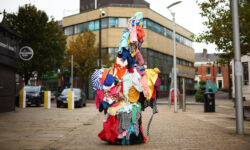
Jeremy Hutchison művész egy lépéssel tovább vitte a küszöbön lévő szemét gondolatát, amikor a “fogyasztás utáni imperializmus szörnyetegévé” vált, egy fulladozó, 2,5 méter magas textilzombi, a Dead White Man formájában. Az alkotás a The Or Foundationnel való együttműködésben készült, és a ghánai obroni wawu kifejezésre utalt, ami annyit tesz: halott fehér ember ruhája. A kantamantói piac kereskedői, így emlegetik a globális északról származó selejtes árukészletet. A Dead White Man októberben fellépett a brit textilbiennálén Blackburnben, majd rögtönzött látogatásokat tett pár ruházati beszállítónál, köztük a Marks & Spencernél. Az M&S egyike azoknak a márkáknak, amelyek címkéi gyakran megjelennek Accra strandjain.
Szeptemberben Clare Press, a Wardrobe Crisis podcast alapítója – amely a fenntartható divat iránt érdeklődők számára elengedhetetlen műsora – kiadta legújabb könyvét, a Wear Next-et: Fashioning the Future (A jövő divatja) című könyvét, amelyben számos ilyen problémára kínál megoldásokat. “A túltermelés és a hipersebesség a divatipar két legnagyobb problémája” – mondja. A Fashion Revolution éves Fashion Transparency Indexében arról számolt be, hogy a nagy divatmárkák 88%-a még mindig nem hozza nyilvánosságra éves termelési volumenét. Az Index szerint globálisan annyi ruha van a rendszerben, hogy a következő hat emberöltőnyi generációt fel tudnánk öltöztetni (ha a bolygó nem megy tönkre előtte).
Továbbá, tavaly kezdte el az európai jogalkotás beleásni magát a fast fashion szabályozásába. Decemberben az Európai Parlament az új “ökodizájn” keretrendszer részeként elfogadta az eladatlan ruhák, kiegészítők és lábbelik megsemmisítésének tilalmát, a ruházati cikkek pedig digitális termékútlevelet kapnak. A várhatóan 2026-ban hatályba lépő QR-kód nagyobb átláthatóságot biztosít majd a vásárlók számára az anyagokról, a gyártásról, sőt, még akár javítási tippeket is adhat. Szabályozás nélkül a márkák még mindig nem vállalnak felelősséget termékeikért, az általuk felhasznált anyagokért és ellátási láncukért. A jogalkotás végre elkezdi őket arra késztetni, hogy kollektív lépéseket tegyenek.
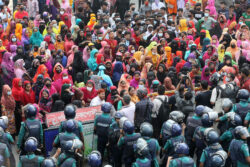
Azonban a ruhaipari munkások folyamatos kizsákmányolása sajnos világszerte folytatódott. 2023-ban volt 10 éve, hogy a bangladesi Dhakában található Rana Plaza gyár katasztrófája során 1134 ember vesztette életét, és legalább 2000-en megsérültek, amikor a gyár összeomlott. Most decemberben pedig több mint 50 márka csatlakozott az újonnan kiterjesztett nemzetközi megállapodáshoz, amely hozzájárult a biztonságosabb munkakörülményekhez több mint 2 millió bangladesi ruhagyári munkás számára, 48 aláírta a bangladesi biztonsági megállapodást és 88 a legutóbbi pakisztáni megállapodást.
Az átláthatóság azonban továbbra is hiányzik. Novemberben egy derbyshire-i nő egy kínai rab személyi igazolványát találta meg a Regatta kabátja ujjbélésében. Az ellátási láncokban rejtőző modern rabszolgaság még mindig jelen van a divatiparban, a szegénységi bérezés pedig még mindig az iparági normák közé tartozik. Amint arról a Clean Clothes Campaign beszámolt, idén június 25-én a bangladesi Tongiban halálra verték Shahidul Islam szakszervezeti vezetőt, aki a munkajogok védelmében tevékenykedett. Az új bangladesi minimálbér elleni folyamatos tiltakozások következtében novemberben négy munkás meghalt, és legalább 115 munkás és szakszervezeti tag került börtönbe. Maeve Galvin, a Fashion Revolution globális politikai és kampányigazgatója szerint “olyan messze vagyunk attól, hogy a munkavállalók elérjék a társadalmi igazságosságot, hogy az szégyenletes“.
Ami viszont reménykeltőbb, hogy a fiatalok előszeretettel vásárolnak használtan, másodkézből online vagy vintage üzletekben. A fast fashion divatmárkák látják, hogy a Depop, a Vinted és az eBay a legnagyobb versenytársaik, és elkezdték értékes kiskereskedelmi területüket a használt ruháknak átadni. A Wear Next című tanulmány szerint, miközben a divatfogyasztás felgyorsul, ezzel párhuzamosan a lassú divat mozgalmának felemelkedését láthatjuk, a javítási forradalom (beleértve a javítási és átalakítási alkalmazásokat, mint például a Sojo és a The Seam) és a DIY divat további virágzását. Reméljük ezen az úton fogunk továbbhaladni!
Forrás: theguardian.com
Fordította: Pölz Klaudia
Fashion Revolution is at COP28 in Dubai this year, alongside Fashion Revolution teams from the UAE, India, Brazil and Pakistan to bring our global voice to the table and advocate for systemic change. In this opinion piece by Liv Simpliciano, our Policy and Research Manager, you can find out more about this year’s conference and what we are demanding from brands below.
What is COP28?
The first Conference of the Parties (COP) was held in 1995. Though the warnings have grown louder, each year we have edged closer toward climate breakdown. Repeated warnings followed by calls to actions and policies have seemingly rung hollow, as they have been inadequate to slow the rate of global warming.
Two years ago, we first attended COP26 in Glasgow. We were told by other attendees that they hoped fashion would be taken seriously by policymakers. However, fashion’s impact on the people and planet has always been serious when talking about the climate crisis.
COP28 is poised to be a global stocktake on progress since the Paris Agreement came into being five years ago. It’s devastatingly clear that countries’ emissions have risen, as have fashion brands’. Major fashion brands need to phase out fossil fuels and phase up renewables – the actions we take now will be the make or break of generations to come.
This COP, the Fossil-Fuel Non-Proliferation Agreement is on the table and seeking a negotiating mandate. The proposed treaty would complement the Paris Agreement by providing the global roadmap needed to halt the expansion of fossil fuel, manage an equitable phase-out of coal, oil and gas, and lay the foundations for a true just energy transition in which no worker, community or country is left behind.
For too long, addressing only emissions reductions and demand without fossil fuel supply has meant countries and companies can continue to claim climate leadership whilst opening, approving and funding new fossil fuel projects. This has to end.
When it comes to fashion, evidence resoundingly demonstrates that the industry is one of the most polluting industries in the world and is one of the core industries driving the pollution of our shared planet. Not only this, it is also one of the wealthiest and most unequal industries in the world. Oxfam’s latest report finds that the richest 1% account for more carbon emissions than the poorest 66% – fashion CEOs are some of the wealthiest people on this planet. It takes just four days for a fashion CEO to earn what a garment worker would earn in their entire lifetime.
View this post on Instagram
Transparency is critical when it comes to addressing the most pressing issues in the fashion industry. A lack of transparency is a continued barrier when it comes to accelerating meaningful impact. Accountability must be unlocked for civil society organisations, citizens, NGOs, worker rights organisations and governments to hold major fashion brands accountable and that is facilitated first and foremost through access to information. There is a persistent lack of transparency when it comes to:
- How many clothes are produced annually and their environmental impacts
- Brands setting robust climate targets, publishing how they were established and reporting on progress
- How brands plan on actually meeting these targets
We have repeatedly seen time-bound targets come and go. There are bare minimum asks that brands should be able to disclose. For example, brands continue to be un-transparent about their annual production volumes – despite the increasing visibility of the fashion industry’s waste problem globally. Brands do not shy away from making bold commitments but these commitments across their supply chains are often made without input from their suppliers who hold important context. There’s no silver bullet solution to the problems in the fashion industry. The needs of supply chain stakeholders are not a monolith and must be addressed with specific context in mind. Top down decision making coupled with the industry’s characteristic unfair purchasing practices are placing pressure on suppliers to be responsible for fixing fashion. Without major fashion brands’ financial commitment and willingness to share financial risk when it comes to decarbonising their supply chains for example, progress will continue to be impeded and with disastrous impacts.
Fashion brands often use COP to announce glossy commitments. Our research in the 2023 Global Fashion Transparency Index shows that once again this year, while brands are telling us more about their policies and commitments, they are telling us much less about what these policies and commitments have achieved. And in the absence of disclosed evidence, it is difficult to understand if the fashion industry is turning things around. We don’t need more commitments – we need more progress.
The stark reality of our planet is that the latest Emissions Gap report finds we are on track to warm by nearly 3 degrees C without aggressive actions, with current levels barreling toward a ‘point of no return’. It is so clear that fashion needs to stop prioritising the money and start listening not only to the science, but to the needs and interests of their suppliers and the people who make our clothes. This has been the case for a very long time and yet when it comes to basic transparency on how brands are performing on their climate targets – a huge lack of transparency (and therefore accountability) remains: less than a third of the 250 major fashion brands reviewed disclose progress on decarbonisation. Aggressive actions are impeded by the lack of transparency because it inhibits the true scale of the problem and obscures where the greatest responsibility for action lies.
Finally – in order to ensure action and progress – policymakers must implement binding regulations, laws and government policies that require transparency and corporate accountability on environmental and human rights issues in the global fashion industry. Without mandatory regulations, major fashion brands can continue to hide from addressing their impacts.
Ultimately, major fashion brands hold the potential to lead the clean energy transition based on their powerful economic influence in their sourcing countries and must leverage this to deliver real renewable energy capacity. Ultimately, there is no fashion on a dead planet.
Read our demands
Header photo by Jay Wennington on Unsplash
Míg a divatbemutatók önmagukban az iparág környezeti hatásának csak egy kis töredékét teszik ki, Rachel Arthur szerint a divatbemutatók a bolygót károsító túlfogyasztást tápláló marketinggépezet középpontjában állnak.
Racher Arthur tanácsadó, író és az ENSZ Környezetvédelmi Programjának fenntartható divatért felelős vezetője és az ő cikkét adjuk közre magyar fordításban.
Az elmúlt hetekben a divatszakma visszaáramlott Párizsból, a luxusipar kétévente megrendezésre kerülő női divathét utolsó és legpompásabb állomásáról.
Vásárlók, hírességek és influencerek százai repültek oda benzinfaló repülőjáratokon, hogy egy pillanatra bepillantást nyerjenek az új kollekciókba, amelyeket gondosan megmunkáltak egy olyan elavuláshoz, amely azt jelenti, hogy mindenki hajlandó lesz újra repülőre ülni, és hat hónap múlva újra megismételni az egészet.
Az biztos, hogy az ezekkel a nagyszabású marketing pillanatokkal közvetlenül összefüggő kibocsátások és hulladékok csepp a tengerben az iparág teljes lábnyomához képest. Az évek során a márkák és a divattanácsok erőfeszítéseket tettek mindkettő csökkentésére.
A bemutatók közvetlen hatására való kizárólagos összpontosítás azonban figyelmen kívül hagyja a nagyobb képet: a divat negatív környezeti és társadalmi hatásának középpontjában a túltermelés és a túlfogyasztás áll. És mit tesznek a divathetek, ha nem mindkettőt táplálják? Vegyük csak a közelmúltbeli New York-i, londoni, milánói és párizsi rendezvények sorát, nem is beszélve a gyakran túlzó módon megrendezett és elő-őszi kollekciókról – minden egyes bemutató beindít egy marketinggépezetet, amelynek célja az új termékek vásárlásának ösztönzése. Az események által inspirált trendek, az általuk biztosított médiaérték és végső soron a vásárlás, amelyre mindezek ösztönöznek, táplálják a környezeti hatásukat.
Ez a divatbemutatók úgynevezett “agylenyomata”: a kifutón való megjelenésnek a fogyasztásra gyakorolt hatása.
“Ha a lábnyomod a működésedet írja le, akkor az agynyomod azt írja le, hogy az embereket milyen érzésekkel töltöd el. Ez az Ön kulturális lenyomata” – mondta Lucy Shea, a Futerra változási ügynökség csoport vezérigazgatója.
A divatbemutatókra költött milliók nem csak a kifutó kollekciók értékesítését mozdítják elő, hanem a szomszédos és könnyebben hozzáférhető termékek – a táskáktól az illatokig – sokkal szélesebb körű fogyasztását ösztönzik, valamint a tömegpiaci másolatok iránti keresletet is.
A reklámipar felismerte ezt a dinamikát. A Purpose Disruptors, egy korábbi reklámszakemberekből álló szervezet, amelynek célja az éghajlatváltozás katalizálása, bevezette a reklámozott kibocsátás fogalmát, amely a kampányok által generált forgalomnövekedés mérésére utal. Ez azt mutatja, hogy a reklámok 32 százalékkal növelik az Egyesült Királyságban minden egyes ember éves szén-dioxid-kibocsátását.
Talán szükségünk lenne egy ezzel egyenértékű elszámolási folyamatra a divatmarketing számára. Nevezzük el “trendkibocsátásnak” – egy olyan mód, amellyel mérhető a luxus imázsépítés által vezérelt fogyasztás hatása.
Ez azért fontos, mert a divat csak akkor fogja elérni fenntarthatósági céljait, ha csökkenti az eladott termékek mennyiségét. De a luxus agynyomása – a divatbemutatóktól kezdve a szerkesztőségi fotózásokig, reklámkampányokig és influencer posztokig, amelyeket elősegítenek – jelenleg az ellenkezőjére ösztönöz, arra buzdítva a vásárlókat, hogy vásároljanak a villámgyorsan változó trendeknek
Ezt az ENSZ Környezetvédelmi Programja és az ENSZ Éghajlatváltozással foglalkozó szervezete a Fenntartható divatkommunikációs útmutatóban (Sustainable Fashion Communication Playbook) https://www.unep.org/interactives/sustainable-fashion-communication-playbook/ állapította meg. Ez egy felhívás a túlzott fogyasztás üzeneteinek felszámolására, beleértve a hagyományos divatbemutatókat is, és ehelyett a fenntartható fogyasztás irányába kell terelni az erőfeszítéseket.
Ennek nem kell a divathetek halálát jelentenie – ahogyan a fenntartható divatágazat sem követeli meg a divat teljes megszűnését. De mindkettő radikális változást igényel.
Az olyan bemutatók, ahol milliókat költenek a gazdagság pillanatnyi és extravagáns fitogtatására (mindezt azért, hogy a kapcsolódó márka- és médiaértékből további milliókat nyerjenek vissza), nem aktuálisak egy olyan időszakban, amikor iparágként hozzájárulunk a bolygórendszerek eróziójához, amelyektől a túlélésünk függ, és eközben emberek millióit sújtjuk, főként a fejlődő országokban.
Ez áll a középpontjában annak, hogy Amy Powney, a fenntarthatóságra összpontosító Mother of Pearl luxusmárka kreatív igazgatója miért nem tart többé divatbemutatókat.
“Az éghajlati összeomlás idején ez durvának és szükségtelennek tűnt” – mondta. Ehelyett arra kellene használnunk az ilyen alkalmakat, hogy támogassuk és ünnepeljük azokat, akik megmutatják, hogy másképp is lehet.
A koppenhágai divathét az alternatív megközelítés egyik példája: A tervezőknek 2023-tól 18 konkrét fenntarthatósági követelménynek kell megfelelniük ahhoz, hogy bemutatót tarthassanak. Többek között nem szabad megsemmisíteniük a korábbi kollekciók eladatlan ruháit, a bemutatott ruhák legalább felének jobb anyagokból kell készülnie, és a márkáknak vállalniuk kell, hogy platformjaikat a vásárlók oktatására és tájékoztatására használják a fenntarthatósági gyakorlatukról. Bár van még hova fejlődni, más nagyvárosokkal összehasonlítva ez egy nagy nyilatkozat.
Most azokra van szükségünk, akik ismét nagyobb léptékben gondolkodnak arról, hogyan mutassuk be a divattal való kapcsolat új módjait. Végül is ez már nem a fokozatos változás ideje. Az átalakulást fel kell turbózni, új rendszereket és üzleti modelleket kell kifejleszteni – olyanokat, amelyek nem arra épülnek, hogy egyszerűen egyre több és több új dolgot adnak el, és nem gondolnak az emberekre, a bolygóra, sőt a profitra gyakorolt hosszú távú hatásokra. A divatbemutatók újragondolása ennek része.
A divat maga is felismerte a változás szükségességét. A világjárvány idején az iparágon belül egyre többen kérték, hogy reformálják meg a divathetek könyörtelen forgását, ami a független tervezők számára pénzügyileg bénító lehet.
Ahelyett, hogy a platformok egy elavult, elromlott rendszert táplálnának, a divatheteknek lehetőséget kellene adniuk egy új rendszer elképzelésére. A márkáknak arra kellene használniuk őket, hogy rávilágítsanak a megoldásokra, valamint hogy felemeljék és ösztönözzék a tudatos fogyasztás körüli törekvéseket. Erre már vannak példák. Az idei szezonban Párizsban Stella McCartney a kifutón tartott bemutatóját az alacsonyabb környezeti terhelésű anyaginnovációk piacával egészítette ki. New Yorkban Maria McManus tervező a bemutató végeztével a közönséggel együtt végigvezette, hogyan készültek az egyes darabok a fenntarthatóság jegyében.
Ünnepeljük azokat is, akik a körforgásos megoldásokat helyezik előtérbe; azokat, akik a hulladékot erőforrássá alakítják, és arra ösztönzik a fogyasztókat, hogy szeressenek bele az olyan fogalmakba, mint a használt és újrahasznosított divat. Egy párizsi divathét csereboltja, amelyben a szokásos első soros versenyzők is részt vennének, nem csak hatalmas nyilatkozat lenne, hanem talán az egyik legnagyszerűbb divatbemutató, amelyet a mai divatipar valaha is látott.
Itt van egy kreatív lehetőség arra, hogy az ember használja az agylenyomat erejét, és új utat kovácsoljon. Bár a kreativitást nem szabad korlátozni, azt feltétlenül át kell irányítani.


